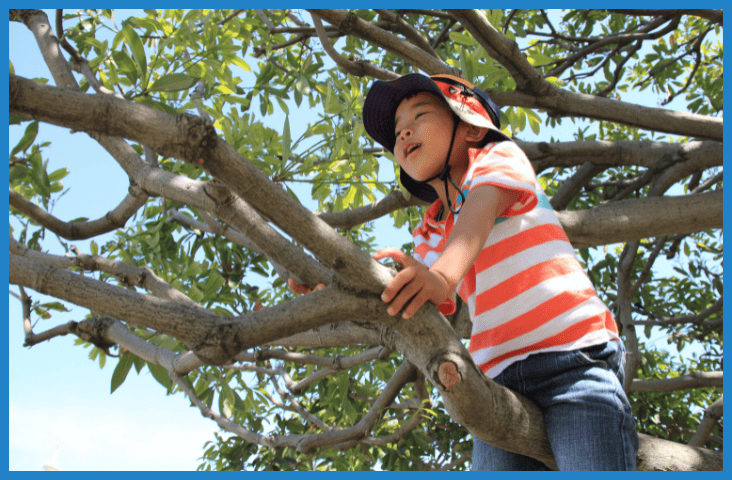
The Power of Risky Play: Nurturing Children’s Growth and Resilience
As parents, it’s natural to worry about our children’s well-being. We want to shield them from pain, and protect them from any harm that may come their way. After all, it’s our job to keep them safe. We ensure they’re wearing their seatbelt, putting on sunscreen, and holding our hand when they cross the street. And should we perceive potential danger in any situation, it’s only natural that our protective instincts kick into high gear.
However, it’s essential to recognise that not all risks are equal, and not all dangers can be avoided. Shielding our children completely from risk may inadvertently deprive them of valuable opportunities for growth, learning, and self-discovery. This is particularly true when it comes to children taking risks during play.
Risky play allows children to develop essential life skills while experiencing a sense of freedom, adventure, and self-discovery. But unfortunately, research suggests that advances in technology and changes in societal norms have altered the landscape of childhood. With increased screen time and structured activities, today’s children have fewer opportunities for unstructured, free play.
We are actively discouraging our children from taking risks.
And I have seen this first-hand at playgrounds, schools and childcare centres. We have hands-off policies that prevent wrestling, roughhousing and jostling on the playground. Children are not allowed to run or play tag, they are discouraged from going up the slide, told to get down, slow down, and stop jumping, climbing and swinging. I even recently heard of a school that removed monkey bars entirely after a child fell from them.

And I understand the desire to keep our children safe. After all, I’m a mother too. But we need to ask ourselves, what are our children missing out on when we prevent them from taking any kind of risks? Especially in play?
Because risky play has extraordinary psychological benefits for children. So let’s talk about how embracing risky play can nurture our children’s brains, relationships, and resilience while fostering emotional health and wellbeing and allowing for optimal development. I’ve even got some practical tips to help you feel more comfortable with risky play and to incorporate more of it into your child’s day-to-day routine!
5 Benefits of risky play for children:
1. It encourages optimal brain development:
Engaging in risky play activates various regions of the brain, fueling cognitive growth and creativity. Whether it’s climbing trees, balancing on narrow beams, or venturing into unfamiliar territories, children engaging in risky play are constantly assessing risks and making decisions. These experiences stimulate the prefrontal cortex, the area of the brain responsible for executive functions such as problem-solving, decision-making, and impulse control. By challenging themselves in these environments, children develop critical thinking skills and learn to navigate uncertainty, which is essential for their future success.
2. It cultivates resilience:
Risky play provides children with invaluable opportunities to confront challenges and cultivate resilience. When children face obstacles or take risks, they learn to manage fear, develop coping strategies, and build self-confidence. The ability to assess risks, make informed decisions, and navigate uncertain situations instills a sense of resilience that serves children well throughout their lives. By allowing children to engage in risky play, parents offer them a safe space to develop these crucial life skills.

3. It nurtures relationships:
Risky play often involves social interaction, and facilitates the development of strong relationships and social skills among children. Collaborating on building forts, negotiating roles in imaginative play, or overcoming challenges together fosters teamwork and cooperation. This kind of risky play helps children learn effective communication and conflict resolution skills, while also giving them shared experiences that allow them to feel connected to each other, help them develop empathy for others and promote a sense of belonging. The social skills acquired during risky play lay the foundation for healthy relationships and social interactions in the future.
4. It enhances emotional well-being
Risky play provides an outlet for children to express and regulate their emotions. Risky play is often challenging play and while engaging in these challenges, children will experience a range of emotions, from excitement and joy to frustration and fear. When they are met with obstacles and are encouraged to work through them during play, children learn how to manage these emotions effectively. This emotional journey helps children develop emotional intelligence, and build resilience, but also to develop a deeper understanding of their own capabilities and limitations. Additionally, risky play allows children to release pent-up energy and get their sensory needs met, which reduces stress and promotes overall emotional well-being.
5. It enables holistic development
By embracing risky play, parents contribute to their children’s holistic development. The combination of physical exertion, cognitive engagement, emotional exploration, and social interaction creates a rich and dynamic learning experience. Children develop a sense of adventure, curiosity, and a lifelong love for learning. They also become adaptable, open-minded, and creative individuals unafraid to take calculated risks in pursuit of their goals.

But what if they get hurt?
There are many concerns and fears that arise for parents when it comes to allowing risky play, and these concerns are valid. Children will sometimes get hurt during risky play, so it’s important for us as adults to carefully weigh up the risks of the situation against the benefits. We, of course, do not want to put our children in danger, so ultimately we need to use our own judgement and ensure we are not placing children into situations they are not developmentally ready for or capable of managing.
However, it is important to note that many parents overestimate the risk involved in these situations, and underestimate their child’s capacity to manage it.
And reflecting on our own childhood experiences can offer valuable insights into our attitudes towards risky play. Our own upbringing shapes our perception of risk and influences how comfortable we are with allowing our children to engage in risky play. If you were shielded from any form of danger as a child, you may be more cautious and risk-averse as an adult. So if you are struggling to allow this kind of play, I recommend a little bit of self-reflection here. Try asking yourself if you are preventing your child from engaging in risky play because they are in real danger, or because you are feeling anxious. If it’s the latter – think about what might help you feel less anxious in this situation, while still allowing your child to get their needs met.

How to Encourage More Risky Play in Your Child’s Life:
Now that we understand the benefits of risky play, let’s explore practical ways to incorporate it into our children’s lives:
1. Create an Enriched Play Environment:
Designate a space in your backyard or find a local park where children can engage in risky play. Provide opportunities for climbing, balancing, and exploring nature. Incorporate natural elements such as logs, rocks, and sand for open-ended play and creativity. Or even consider installing a sturdy climbing structure or a treehouse to encourage physical challenges and exploration.
2. Support Risk Assessment:
Encourage children to assess risks and make informed decisions independently. Ask questions that prompt them to evaluate the potential risks involved in their play. For example, “What do you think might happen if you climb that tree? How confident are you that that branch will hold your weight?” This helps children develop their risk assessment skills and empowers them to make responsible choices. It’s important to strike a balance between providing guidance and allowing children to experience the thrill of personal achievements and learn from their own mistakes.
3. Use Your Presence to Create Safety
Be present to offer reassurance and comfort, while still allowing children to take calculated risks and develop their abilities. Let them know that you are there to support them and provide assistance if needed. Use encouraging statements such as, “I believe in you! Take your time and trust yourself. Remember, I’m right here if you need any help.” This helps children feel safe and supported while also exploring their boundaries.

4. Foster Peer Interactions:
Arrange playdates or group activities where children can engage in risky play together. Encourage teamwork, cooperation, and problem-solving among peers, creating a supportive environment where children feel encouraged to explore their boundaries. When children play with others, they learn valuable social skills such as negotiation, compromise, and empathy. Group play also adds an element of excitement and motivation, encouraging children to take on new challenges and push their limits in ways they may not have if they were playing alone.
5. Be a Role Model:
Children learn by observing their parents and caregivers. Demonstrate your own willingness to embrace calculated risks and step outside your comfort zone. Engage in adventurous activities with your children, showcasing the joy and fulfilment that comes from taking on challenges. By being a positive role model, you inspire your children to explore, experiment, and push their boundaries in a safe and supportive way.
6. Provide Age-Appropriate Tools and Equipment:
Equip your child with age-appropriate tools and equipment that facilitate risky play. For example, provide them with sturdy bikes, skateboards, or scooters for outdoor adventures. Encourage the use of basic tools like hammers, nails, and saws for supervised building projects. These tools not only enhance their physical skills but also promote problem-solving and creativity.

7. Encourage Outdoor Exploration:
Make time for regular outdoor adventures in natural environments such as parks, forests, or beaches. Encourage your child to explore their surroundings, climb trees, jump over small streams, and navigate uneven terrain. Nature provides a rich environment for risky play, offering opportunities for sensory exploration, problem-solving, and physical challenges.
8. Celebrate Achievements and Efforts:
Acknowledge and celebrate your child’s achievements and efforts during risky play. Recognise their courage, perseverance, and problem-solving abilities. By praising their resilience and acknowledging their progress, you build their self-confidence and motivation to continue exploring and taking calculated risks.
Risky play holds profound psychological benefits for children, nurturing their brains, relationships, and ability to cope with challenges. By embracing the magic of risky play, and creating safer opportunities for children to engage in this kind of play while under the supervision of caring, protective adults, we can cultivate emotionally healthy individuals who are equipped to thrive in an ever-changing world. So let’s encourage our children to explore, take risks, and unleash their true potential.
Sarah Conway is a child and adolescent psychologist, mother of 4, and founder of Mindful Little Minds. She has over 15 years of experience working in mental health with children, teenagers, and families. Sarah’s mission is to help parents move away from punitive parenting strategies and towards mindful, intentional parenting that builds emotional intelligence in children and parents alike. As a busy mum herself, she knows firsthand how difficult mindful parenting can be, particularly when it was never modeled by our own parents. That’s why she provides parents and children with simple, practical strategies and tools that help them learn to manage emotions – together. She believes that changing the way we parent will change the world.


